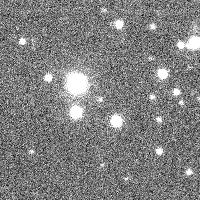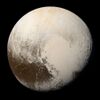Astronomy:2010 KZ39
| Discovery[1][2][3] | |
|---|---|
| Discovered by |
|
| Discovery site | Las Campañas Obs. (first observed) |
| Discovery date | 21 May 2010 (first observed) |
| Designations | |
| 2010 KZ39 | |
| Minor planet category | |
| Orbital characteristics[4][5] | |
| Epoch 16 February 2017 (JD 2457800.5) | |
| Uncertainty parameter 5 | |
| Observation arc | 1.83 yr (669 days) |
| |{{{apsis}}}|helion}} | 47.825 AU |
| |{{{apsis}}}|helion}} | 42.965 AU |
| 45.395 AU | |
| Eccentricity | 0.0535 |
| Orbital period | 305.86 yr (111,714 days) |
| Mean anomaly | 256.31° |
| Mean motion | 0° 0m 11.52s / day |
| Inclination | 26.032° |
| Longitude of ascending node | 53.118° |
| |{{{apsis}}}|helion}} | ≈ 6 May 2110[6] ±5 months |
| 313.91° | |
| Physical characteristics | |
| Geometric albedo | 0.10 (assumed)[7] |
| Apparent magnitude | 20.7[11] |
| Absolute magnitude (H) | |
2010 KZ39 is a trans-Neptunian object orbiting the Sun as a detached object in the outer reaches of the Solar System. The object was first observed on 21 May 2010 by astronomers Andrzej Udalski, Scott Sheppard, M. Szymanski and Chad Trujillo at the Las Campañas Observatory in Chile.[1][3]
Description
2010 KZ39 orbits the Sun at a distance of 42.9–47.8 AU once every 305 years and 3 months (111,504 days), similar to Makemake, Chaos and other bodies that circle the Sun in 6:11 resonance to Neptune. Its orbit has an eccentricity of 0.05 and an inclination of 26° with respect to the ecliptic.
Using the best-fit values for its orbit, it is expected to come to perihelion in 2109.[4] It has been observed 28 times over 3 oppositions and has an uncertainty parameter of 5.[1] As of 2016, is 46.1 AU from the Sun.[11] The body's spectral type as well as its rotation period remain unknown.
Brown assumes an albedo of 0.09 and magnitude of 4.5, resulting in an estimated diameter of 574 kilometers.[10] However, because the albedo is unknown and it has a currently estimated absolute magnitude of 4.03±0.01,[9] its diameter could easily fall between 414 and 933 km[8] for an assumed albedo between 0.25 and 0.05, respectively.
References
- ↑ 1.0 1.1 1.2 "(2010 KZ39)". Minor Planet Center. http://www.minorplanetcenter.net/db_search/show_object?object_id=471143.
- ↑ "MPEC 2010-L38 : 2010 KZ39". IAU Minor Planet Center. 2010-06-08. http://www.minorplanetcenter.org/mpec/K10/K10L38.html.
- ↑ 3.0 3.1 All four named discoverers are uncredited in sources.
- ↑ 4.0 4.1 4.2 4.3 "JPL Small-Body Database Browser: (2010 KZ39)". Jet Propulsion Laboratory. http://ssd.jpl.nasa.gov/sbdb.cgi?sstr=3525142.
- ↑ 5.0 5.1 Marc W. Buie. "Orbit Fit and Astrometric record for 10KZ39". SwRI (Space Science Department). http://www.boulder.swri.edu/~buie/kbo/astrom/10KZ39.html.
- ↑ JPL Horizons Observer Location: @sun (Perihelion occurs when deldot changes from negative to positive. Uncertainty in time of perihelion is 3-sigma.)
- ↑ 7.0 7.1 7.2 "LCDB Data for 2010 KZ39". Asteroid Lightcurve Database (LCDB). http://www.minorplanet.info/PHP/generateOneAsteroidInfo.php?AstInfo=0%7C2010+KZ39.
- ↑ 8.0 8.1 Dan Bruton. "Conversion of Absolute Magnitude to Diameter for Minor Planets". Department of Physics & Astronomy (Stephen F. Austin State University). http://www.physics.sfasu.edu/astro/asteroids/sizemagnitude.html.
- ↑ 9.0 9.1 9.2 Benecchi, Susan D.; Sheppard, Scott S. (May 2013). "Light Curves of 32 Large Transneptunian Objects". The Astronomical Journal 145 (5): 19. doi:10.1088/0004-6256/145/5/124. Bibcode: 2013AJ....145..124B. http://adsabs.harvard.edu/cgi-bin/bib_query?bibcode=2013AJ....145..124B. Retrieved 3 April 2017.
- ↑ 10.0 10.1 Michael E. Brown. "How many dwarf planets are there in the outer solar system? (updates daily)". California Institute of Technology. http://web.gps.caltech.edu/~mbrown/dps.html.
- ↑ 11.0 11.1 "AstDyS: 2010 KZ39 Ephemerides". AstDyS. https://newton.spacedys.com/astdys/index.php?pc=1.1.3.0&n=2010+KZ39.
External links
- Large New Trans-Neptunian Object 2010 KZ39 Discovered (BAA Blog : 9 June 2010)
- OCKS: OGLE Carnegie Kuiper belt Survey (OCKS is a Southern sky survey searching for Kuiper Belt objects and dwarf planets)
- 2010 KZ39 at AstDyS-2, Asteroids—Dynamic Site
- 2010 KZ39 at the JPL Small-Body Database
 |




